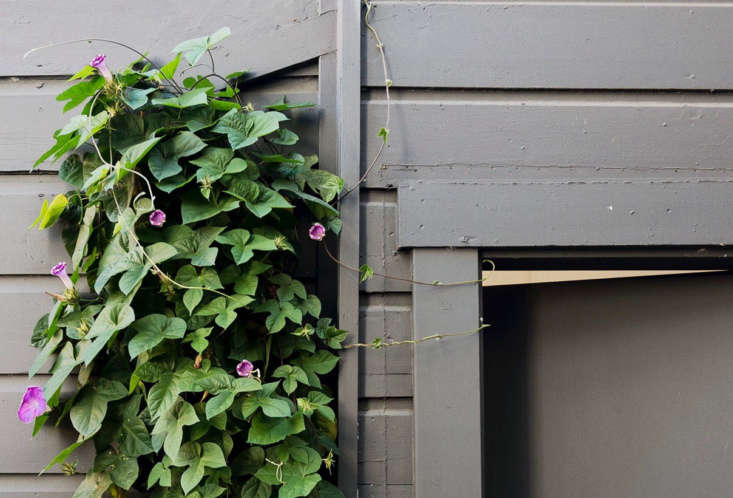Here’s a question for you: Is a garden complete without a vine? Some may passionately argue that it isn’t, as this type of plant adds another dimension and potential burst of color or fragrance to a garden that other plants can’t provide. I, myself, am a mild vine enthusiast. Maybe it’s because vines, in general, can be tricky to maintain and, if not done properly, become a brambly, ugly mess. A well trimmed vine, though? That, I can get behind.
Here are ten facts about vines—their nature, habits, and abilities—that might skew your attitude toward (or against) them.
N.B.: Featured photograph, above, of Alice Waters’s garden by Leslie Williamson, from Californians at Home: Intimate Portraits by Leslie Williamson.
1. Not all vines are vines.

Did you know that in some parts of the world the term “vine” refers solely to grape vines and the term “climber” is used for plants that climb. To make matters even more confusing, there are plants that behave like vines but aren’t technically a vine. These are called scramblers like some shrub roses that can be trained to climb. So, what exactly defines a vine? It’s a plant whose woody stem needs support to climb and it uses tendrils or it twines up a structure. A vine can also sprawl along the ground.
2. Some won’t return year after year.

Some vines are evergreen (like jasmine), some are deciduous and lose their leaves (like Boston ivy), and some (like clematis) have both evergreen and deciduous types. Some vines should be treated as annuals (like sweet peas), and some vines are invasive in certain areas and are difficult to eradicate (like blue morning glory vine, Japanese honeysuckle, and English ivy). Pro tip: Before choosing any vine, check with your local extension service to make sure it isn’t invasive in your area.
3. Vines don’t all climb in the same way.

There are vines that twist and twine around an object all by themselves (like jasmine). Others definitely need a little help as they climb their way upward (like bougainvillea). And then there are those that cling to surfaces (like creeping fig). Some twining vines use stems to twine and others use leaves. The bottom line: Vines use different methods, depending on the species, to climb and take advantage of surfaces and supports provided. For example, clematis has no problem traveling up a trellis but will struggle to climb a vertical support like a pole.
4. You can grow some vines from seed.

Quick growing annual vines can be grown from seed. One of my favorite fragrant ones is sweet pea. Not only does it make a fantastic cut flower, but it is easy to start. Another vine that actually grows quicker and more successfully from seed than from nursery starts is climbing nasturtium. Other options includes: purple hyacinth bean vine, black-eyed Susan vine, and passion flower.
5. There’s a type of vine you may have never heard of before.

Climbing plants known as lianas are considered vines, but what sets them apart visually is that they have long, very woody stems. These type of vines also find great pleasure competing with trees for water, sunlight, and soil nutrients. To survive and thrive they attach themselves to trees via aerial shoots and then hike toward the top, crafting a network of heavy duty living cables that bridge from tree to tree. Most of these lianas are found in tropical rain forests or arboretums, while some are more common, like grape vines and wisteria.
6. Vines make great cut flowers.

You can think beyond traditional uses for vines and consider cutting some to add to vases and flower arrangements. Good candidates include: cup and saucer vine, nasturium, fragrant sweet pea, clematis, hops, and pink jasmine.
7. Got a vine? Get to know your pruners.

Luckily there are some low-maintenance choices like creeping fig vine that need little care. Most, though (including wisteria and pink jasmine), are a bit needy and, without proper routine pruning, get woody and unattractive. The best time to prune a vine is right after it finishes flowering.
8. They like a brutal cut.

Got a vine that you neglected to prune for awhile? Well, luckily you can just bite the bullet and cut it to the ground in the early spring. Most hardy and healthy vines will respond to this harsh hair cut and return quite nicely, but this is usually a last resort.
9. Most every vine needs some support.

Even vines that are fairly self-sufficient and can climb like a big kid all by themselves (e.g., climbing hydrangeas) without needing a trellis may require a wee bit of help in the beginning. Without a sturdy stick or wire system, they may flop to the ground and take a while to creep up. Plan ahead and set up a sturdy system before planting. Also add to your garden arsenal some green tape or wire.
10. There are good and not so good times to plant a vine.

As with most plants, the best time to add a vine to your garden is in the late spring after the last frosty days or in the fall when temperatures cool down a bit and rain is hopefully on the way. Before purchasing your vine, make sure you research the hardiness of your vine and match it to your climate so you don’t lose it in an unforgiving winter.
See also:
- Everything You Need to Know About Houseplant Vines
- Greatest Hits 2022: Lablab—An Ancient Crop and Stunning Vine
- Vines Gone Wild: 10 Rooms with Creeping Greenery












Have a Question or Comment About This Post?
Join the conversation (0)